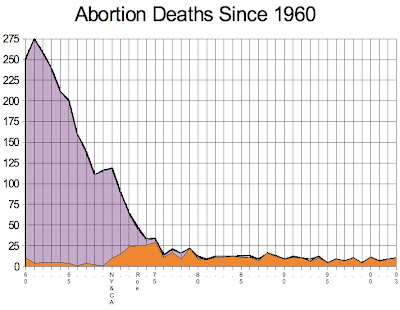As you can see from the graph below, abortion deaths were falling dramatically before legalization. This steep fall had been in place for decades. To argue that legalization lowered abortion mortality simply isn't supported by the data.

While visiting a friend who had just given birth, 30-year-old Catherine Mau asked another friend, Catherine Beyer, to come with her to the office of Chicago midwife Anna Heisler for an abortion. On February 13, 1929, two Catherines went together, and according to Beyer, Mau told the midwife that "she had three children and her husband was out of work and she could not support another one, and that her husband was sickly." Beyer waited while the midwife took Mau into another room and inserted a catheter. The two women parted ways and each went home to her husband and children. Two days later, Beyer met the midwife at Mau's home and helped her “wash her out” and put her to bed. Beyer then took care of Mau's children. About two weeks later, Mau's husband Frank called a doctor to report that his wife was in great pain. A doctor told Catherine Mau that she was near death. Mau reportedly said, “What will my children do?” A few weeks later, on March 11, Catherine died from infection. On July 20, 1929, Heisler was sentenced to Joliet Penitentiary for Catherine's death. She had already done time in Joliet for the May 30, 1919 abortion death of 43-year-old Lena Benich, but had been freed after winning an appeal.
On March 11, 1915, 40-year-old homemaker Emma Jonas died at Chicago's German American Hospital after an abortion perpetrated by Cecelia Styskal. Though Styskal was arrested and held by the Coroner, the case never went to trial.
Note, please, that with issues such as doctors not using proper aseptic techniques, lack of access to blood transfusions and antibiotics, and overall poor health to begin with, there was likely little difference between the performance of a legal abortion and illegal practice, and the aftercare for either type of abortion was probably equally unlikely to do the woman much, if any, good. In fact, due to improvements in addressing these problems, maternal mortality in general (and abortion mortality with it) fell dramatically in the 20th Century, decades before Roe vs. Wade legalized abortion across America.

No comments:
Post a Comment